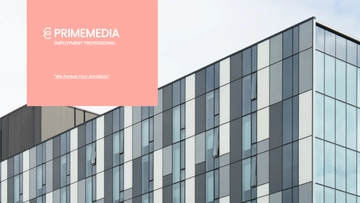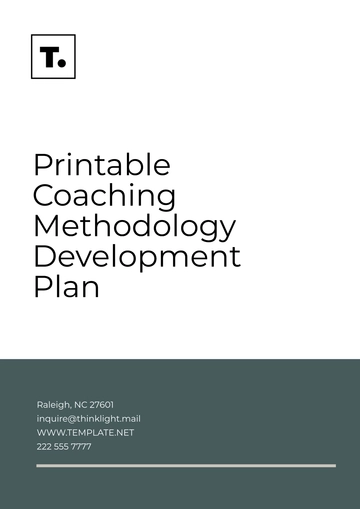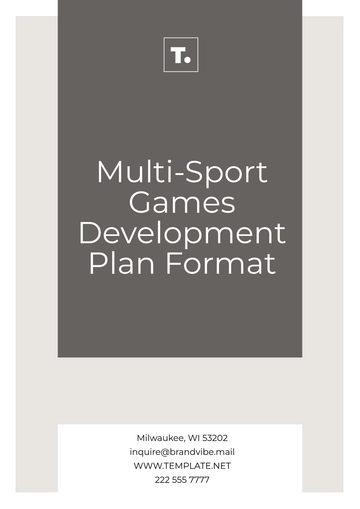Free Cleaning Services Staff Training and Development Plan

I. Introduction:
Welcome to the [Your Company Name] Staff Training and Development Plan. At [Your Company Name], we understand the critical role that well-trained and skilled cleaning staff play in delivering exceptional service to our clients. This comprehensive plan has been meticulously crafted to assess the training needs of our employees, develop tailored training objectives and curriculum, and implement effective training methods to enhance their skills, knowledge, and abilities in cleaning services. Through this program, we aim to empower our cleaning staff to uphold the highest standards of cleanliness, safety, and customer satisfaction, positioning [Your Company Name] as a leader in the cleaning services industry.
II. Training Needs Assessment
At [Your Company Name], we recognize the importance of continually improving the skills and knowledge of our cleaning staff to deliver exceptional service to our clients. To ensure our employees are equipped with the necessary competencies, we will conduct a thorough Training Needs Assessment (TNA) using the following methods:
Performance Evaluations: Supervisors will assess the performance of cleaning staff members based on key performance indicators such as quality of cleaning, adherence to safety protocols, and customer satisfaction ratings.
Employee Surveys: We will administer surveys to gather feedback from cleaning staff regarding their training needs, areas for improvement, and interests in further development opportunities.
Client Feedback: Solicit feedback from our clients regarding their satisfaction with the cleaning services provided, identifying any areas where additional training or improvement may be required.
Safety Compliance Audit: Conduct audits to ensure compliance with safety regulations and identify any gaps in safety knowledge or practices among cleaning staff.
III. Training Objectives
Based on the findings from the Training Needs Assessment, the following objectives have been established for the [Your Company Name] Staff Training and Development Program:
Enhance Cleaning Techniques: Improve cleaning staff's proficiency in utilizing cleaning equipment, products, and techniques to achieve optimal cleanliness and sanitation standards.
Safety Training: Provide comprehensive training on safety protocols, including proper handling of cleaning chemicals, use of personal protective equipment (PPE), and procedures for preventing accidents and injuries.
Customer Service Skills: Develop communication and interpersonal skills among cleaning staff to enhance their ability to interact effectively with clients, address customer concerns, and maintain positive relationships.
Efficiency and Time Management: Equip cleaning staff with strategies for maximizing efficiency, prioritizing tasks, and managing time effectively to complete cleaning assignments within designated timeframes.
IV. Training Curriculum
The CES Staff Training and Development Program will encompass the following curriculum modules:
A. Introduction to Cleaning Techniques:
Description:
This module provides an overview of fundamental cleaning techniques essential for maintaining cleanliness and sanitation in various environments. Topics covered include surface preparation, proper use of cleaning agents and equipment, effective cleaning methods for different surfaces, and strategies for achieving optimal results.
Learning Objectives:
Understand the importance of cleanliness and sanitation.
Identify different types of cleaning agents and their appropriate uses.
Learn basic cleaning techniques for different surfaces and materials.
Develop proficiency in using cleaning equipment effectively.
B. Safety Procedures & Equipment Handling:
Description:
This module focuses on safety protocols and procedures to ensure the well-being of cleaning staff and those around them. Topics covered include hazard identification, safe handling and storage of cleaning chemicals, proper use of personal protective equipment (PPE), emergency response procedures, and safe handling of cleaning equipment.
Learning Objectives:
Identify potential hazards in the workplace and take appropriate precautions.
Understand the importance of proper ventilation and personal protective equipment.
Learn safe handling and storage practices for cleaning chemicals.
Demonstrate knowledge of emergency response procedures in case of accidents or spills.
C. Customer Service Skills:
Description:
This module focuses on developing communication and interpersonal skills necessary for providing excellent customer service. Topics covered include effective communication techniques, active listening, empathy, conflict resolution, and strategies for building positive relationships with clients.
Learning Objectives:
Understand the importance of customer service in the cleaning industry.
Develop effective communication skills for interacting with clients and colleagues.
Learn techniques for active listening and empathetic communication.
Develop strategies for resolving conflicts and addressing customer concerns.
D. Hands-On Cleaning Demonstrations:
Description:
This module provides hands-on training and demonstrations to reinforce cleaning techniques taught in the classroom. Participants will have the opportunity to practice various cleaning methods, use different cleaning agents and equipment, and receive feedback from instructors to enhance their skills.
Learning Objectives:
Apply theoretical knowledge of cleaning techniques in practical scenarios.
Develop proficiency in using cleaning equipment and products effectively.
Receive feedback from instructors to improve cleaning techniques.
Gain confidence in performing cleaning tasks to meet quality standards.
E. Time Management & Efficiency:
Description:
This module focuses on strategies for maximizing productivity and efficiency in cleaning operations. Topics covered include task prioritization, time-saving techniques, workflow optimization, and effective use of resources to complete cleaning assignments within designated timeframes.
Learning Objectives:
Understand the importance of time management in cleaning operations.
Learn techniques for prioritizing tasks and managing workload effectively.
Identify opportunities for workflow optimization and resource utilization.
Develop strategies for minimizing downtime and maximizing productivity.
F. Equipment Maintenance:
Description:
This module covers the maintenance and care of cleaning equipment to ensure optimal performance and longevity. Topics include regular maintenance schedules, cleaning and lubrication procedures, troubleshooting common issues, and safety precautions during equipment maintenance.
Learning Objectives:
Understand the importance of equipment maintenance in prolonging equipment lifespan.
Learn proper cleaning and lubrication techniques for different types of cleaning equipment.
Identify common issues with cleaning equipment and troubleshoot them effectively.
Demonstrate knowledge of safety precautions during equipment maintenance tasks.
V. Training Methods
The [Your Company Name] Staff Training and Development Program will utilize a variety of training methods to accommodate different learning styles and ensure effective knowledge transfer:
Classroom Training: Instructor-led sessions conducted in a traditional classroom setting provide participants with theoretical knowledge and foundational concepts. These sessions are structured to cover topics such as cleaning techniques, safety procedures, customer service skills, time management, and equipment maintenance. Classroom training allows for interactive discussions, presentations, and Q&A sessions, fostering a conducive learning environment.
Hands-On Demonstrations: Practical hands-on demonstrations complement classroom learning by allowing participants to apply theoretical concepts in real-world scenarios. Trainers demonstrate proper cleaning techniques, equipment operation, and safety procedures, while participants actively engage in practical exercises to reinforce their learning. Hands-on demonstrations provide an opportunity for participants to gain confidence in their skills and receive immediate feedback from instructors.
Online Courses: Accessible through our Learning Management System (LMS), online courses offer flexibility for self-paced learning and remote access to training materials. Participants can access a variety of courses covering topics such as safety training, customer service, and equipment operation. Online courses include interactive modules, videos, quizzes, and downloadable resources, allowing participants to learn at their own pace and revisit material as needed.
Workshops and Group Activities: Interactive workshops and group activities promote collaboration, problem-solving, and skill-building among participants. Workshops may focus on specific topics such as effective communication, conflict resolution, or team building. Group activities, such as role-playing exercises or case studies, provide practical scenarios for participants to apply their learning and develop critical thinking skills in a supportive group environment.
On-the-Job Training (OJT): On-the-job training provides hands-on experience and mentorship opportunities for participants to learn from experienced colleagues in real work settings. New hires and employees requiring additional support receive personalized coaching, guidance, and constructive feedback from supervisors and senior staff members. OJT allows participants to apply theoretical knowledge directly to their job duties, accelerating their learning and skill development.
Vendor Training Sessions: Vendor training sessions conducted by representatives from cleaning equipment and product suppliers offer specialized training on equipment operation, maintenance, and safety precautions. These sessions provide participants with in-depth knowledge of specific cleaning products and technologies, enhancing their proficiency in utilizing company-approved equipment and supplies effectively.
Simulations and Virtual Reality (VR) Training: Advanced training methods such as simulations and virtual reality (VR) training offer immersive learning experiences that simulate real-world cleaning scenarios. Participants can engage in interactive simulations or VR simulations that replicate various cleaning environments, allowing them to practice their skills in a risk-free virtual environment. These cutting-edge training methods enhance engagement, retention, and transfer of learning to real-world situations.
VI. Resource Allocation
[Your Company Name] is committed to providing the necessary resources to support the implementation of the Staff Training and Development Program. The table outlines the resource allocation plan for the program:
Resource | Budget Allocation | Description |
|---|---|---|
Training Materials | $10,000 | Purchase of textbooks, manuals, and training materials |
Instructor Fees | $15,000 | Payment for external trainers and consultants |
Online Courses | $5,000 | Subscription fees for online training platforms and courses |
Facilities | $8,000 | Renting training rooms, equipment, and facilities |
Equipment | $12,000 | Purchase and maintenance of cleaning equipment and supplies |
Personnel | $20,000 | Compensation for internal trainers, supervisors, and support staff |
VII. Instructor Selection
Qualified instructors will be selected based on their expertise, experience, and instructional skills. Instructors may include:
Internal Trainers: Experienced cleaning supervisors or senior staff members with in-depth knowledge of cleaning techniques, safety protocols, and customer service practices.
External Consultants: Subject matter experts or training professionals specializing in cleaning services, safety compliance, and customer service training.
Vendor Representatives: Representatives from cleaning equipment and product suppliers may conduct training sessions on equipment operation, maintenance, and safety precautions.
VIII. Training Schedule
The following table presents an overview of the training schedule designed for the staff of [Your Company Name]. This schedule outlines the dates, times, training topics, trainers, and locations for each session.
Date | Time | Training Topic | Trainer | Location |
|---|---|---|---|---|
April 1, 2024 | 9:00 AM - 12:00 PM | Introduction to Cleaning Techniques | Internal Trainer | Training Room 1 |
April 1, 2024 | 1:00 PM - 3:00 PM | Safety Procedures & Equipment Handling | External Consultant | Training Room 1 |
April 2, 2024 | 9:00 AM - 11:00 AM | Customer Service Skills | Internal Trainer | Training Room 2 |
April 2, 2024 | 1:00 PM - 4:00 PM | Hands-On Cleaning Demonstrations | Internal Trainer | On-Site Training Area |
April 3, 2024 | 9:00 AM - 12:00 PM | Time Management & Efficiency | Internal Trainer | Training Room 1 |
April 3, 2024 | 1:00 PM - 3:00 PM | Equipment Maintenance | Vendor Representative | Training Room 1 |
IX. Evaluation and Feedback Mechanisms
[Your Company Name] will implement various evaluation and feedback mechanisms to assess the effectiveness of the training program:
Pre- and Post-Training Assessments: Before the commencement of training sessions, participants will undergo pre-training assessments to gauge their baseline knowledge and skills. These assessments will be repeated after the completion of training to measure learning outcomes and knowledge retention. By comparing pre- and post-training assessments, we can assess the effectiveness of the training program in enhancing participants' skills and knowledge.
Participant Feedback Surveys: Following each training session, participants will be invited to provide feedback through surveys. These surveys will solicit participants' opinions on various aspects of the training, including the relevance of the content, effectiveness of the training methods, quality of instruction, and overall satisfaction with the training experience. Feedback gathered from participants will be carefully analyzed to identify areas of strength and areas for improvement in the training program.
Supervisor and Client Feedback: In addition to participant feedback, we will also seek input from supervisors and clients regarding the performance improvement and impact of training on cleaning staff's skills, productivity, and customer satisfaction. Supervisors will be asked to provide feedback on the observable changes in employees' performance following the training, while clients will be surveyed to assess changes in service quality and customer satisfaction levels. This feedback will help us evaluate the real-world impact of the training program on our cleaning services.
Observations and Performance Metrics: Trainers and supervisors will conduct regular observations of cleaning staff's performance in the workplace to assess the application of newly acquired skills and identify areas for further improvement. Performance metrics such as cleanliness scores, customer feedback ratings, and completion times for cleaning tasks will be monitored to track the progress and effectiveness of the training program over time.
Continuous Improvement Process: Feedback gathered from pre- and post-training assessments, participant surveys, supervisor and client feedback, and performance metrics will be reviewed systematically as part of our continuous improvement process. Insights gained from these evaluations will inform adjustments to the training curriculum, methods, and resources to address identified areas for improvement and ensure the ongoing relevance and effectiveness of the training program.
X. Conclusion:
In conclusion, the [Your Company Name] Staff Training and Development Plan reflects our unwavering commitment to investing in our most valuable asset: our employees. By providing them with the necessary tools, resources, and opportunities for growth and development, we are not only strengthening our workforce but also elevating the quality of service we deliver to our clients. As we embark on this journey of continuous improvement, we are confident that our cleaning staff will emerge as highly skilled professionals, capable of meeting and exceeding the evolving needs and expectations of our clients, and contributing to the continued success of [Your Company Name].
- 100% Customizable, free editor
- Access 1 Million+ Templates, photo’s & graphics
- Download or share as a template
- Click and replace photos, graphics, text, backgrounds
- Resize, crop, AI write & more
- Access advanced editor
Empower your cleaning services team with Template.net's Staff Training and Development Plan Template. Editable in our AI Editor Tool, this customizable template provides a structured framework for enhancing skills and knowledge. From safety protocols to customer service, streamline training initiatives and foster professional growth. Elevate your workforce capabilities effortlessly with Template.net!





























